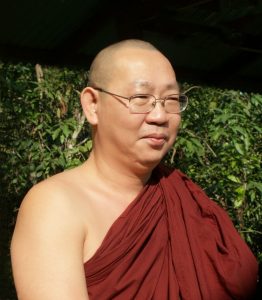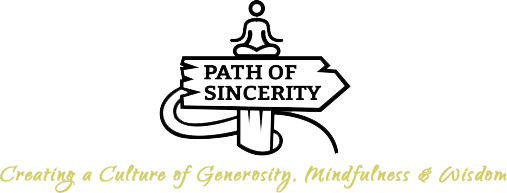David Sudar Lineage
My primary lineage is the Theravāda-Vipassanā Buddhist tradition, particularly as passed through the Burmese monk Shwe Oo Min Sayadaw to his successor & my core teacher, Sayadaw U Tejaniya.
 Sayadaw U Tejaniya Brief Bio:
Sayadaw U Tejaniya Brief Bio:
Sayadaw U Tejaniya began his Buddhist training as a young teenager in Myanmar under the late Shwe Oo Min Sayadaw (1913–2002). After a career in business and life as a householder, he became a permanent monk in 1996 at the age of 36. He now teaches meditation at Shwe Oo Min Dhamma Sukha Forest Meditation Center in Yangon, Myanmar.
His style is marked by a relaxed demeanor and easy sense of humor that belies a commitment to awareness which he encourages his students to apply in every aspect of their lives. Here is a four-page autobiography he wrote in the mid 2000’s (starts on page 26).
Other Key Theravāda Influences:
Also within the Theravāda tradition, my practice and teachings are greatly informed by:
- Early Buddhism; the earliest known Buddhist teachings, which are found in the Pali Canon (technically, pre-Theravāda).
- Contemporary monastic-scholars who teach from an Early Buddhism perspective, including Bhikkhu Analayo, Thanissaro Bhikkhu & Bhikkhu Bodhi.
- A handful of deeply practiced Western teachers, including Gil Fronsdal, Joseph Goldstein, Mark Nunberg, Rob Burbea, Bodhipaksa, and a few of the senior Western students of U Tejaniya, including my mentor Carol Wilson, as well as Steve Armstrong and Andrea Fella.
- The Thai Forest tradition; particularly the teachings of Ajahn Chah, Ajahn Sumedho, Ajahn Pasanno, Ajahn Jayasaro, Ajahn Sucitto, and Pramote Pamojjo.
- The Burmese Vipassanā tradition; apart from U Tejaniya, I’ve also greatly benefited from the teachings of S.N Goenka & Mahasi Sayadaw.
Outside Theravāda, I owe a special debt of gratitude to Thich Nhat Hanh, Robert Augustus Masters, Adyashanti, and Byron Katie. My early years of practice also involved time immersed in Soto Zen Buddhism and classical Yoga, and have continued to inform my sensibilities.
What is Theravāda Buddhism (and Vipassanā)?
The first ~200 years after the Buddha died, there weren’t different schools & sects of Buddhism. There were just followers of the Buddha. However, once different schools broke off, eventually forming Mahayana & Vajrayana Buddhism, among others, the original group that remained intact was called Theravāda, or “the way of the elders.” Over the past 2,000+ years, this lineage has maintained a continuous presence and nowadays is the dominant tradition in Thailand, Sri Lanka, Myanmar, Laos, and Cambodia.
The Theravāda tradition presents a well-rounded spiritual path aimed at awakening, and involves three primary trainings: ethics, wisdom & meditation.
Vipassanā is its style of meditation that focuses on developing wisdom, and is typically translated as Insight Meditation. This style is often paired with samatha meditation (aka concentration or calm-abiding), and together these two form the core of the Theravāda meditative practice. They are both rooted in mindfulness.
Although, a better term than vipassanā to describe what I do would be Satipatthāna meditation, which refers to the discourse where the Buddha laid out his basic meditation approach, enveloping both vipassanā and samatha. One of my favorite all-time books begins with a translation of the 10ish page discourse, and proceeds to break it down in-depth.
If you’re interested in a deeper dive into all this, this article by Gil Fronsdal offers a fantastic overview of Theravāda Buddhism. I also wrote a short article describing the essence of Vipassanā.
